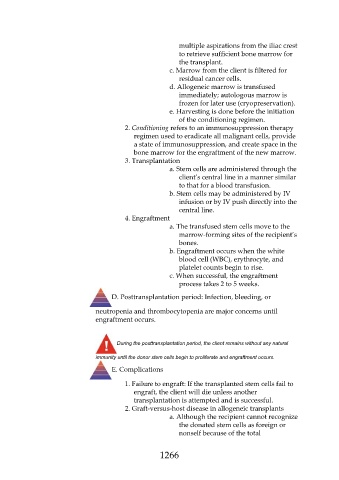Page 1266 - Saunders Comprehensive Review For NCLEX-RN
P. 1266
multiple aspirations from the iliac crest
to retrieve sufficient bone marrow for
the transplant.
c. Marrow from the client is filtered for
residual cancer cells.
d. Allogeneic marrow is transfused
immediately; autologous marrow is
frozen for later use (cryopreservation).
e. Harvesting is done before the initiation
of the conditioning regimen.
2. Conditioning refers to an immunosuppression therapy
regimen used to eradicate all malignant cells, provide
a state of immunosuppression, and create space in the
bone marrow for the engraftment of the new marrow.
3. Transplantation
a. Stem cells are administered through the
client’s central line in a manner similar
to that for a blood transfusion.
b. Stem cells may be administered by IV
infusion or by IV push directly into the
central line.
4. Engraftment
a. The transfused stem cells move to the
marrow-forming sites of the recipient’s
bones.
b. Engraftment occurs when the white
blood cell (WBC), erythrocyte, and
platelet counts begin to rise.
c. When successful, the engraftment
process takes 2 to 5 weeks.
D. Posttransplantation period: Infection, bleeding, or
neutropenia and thrombocytopenia are major concerns until
engraftment occurs.
During the posttransplantation period, the client remains without any natural
immunity until the donor stem cells begin to proliferate and engraftment occurs.
E. Complications
1. Failure to engraft: If the transplanted stem cells fail to
engraft, the client will die unless another
transplantation is attempted and is successful.
2. Graft-versus-host disease in allogeneic transplants
a. Although the recipient cannot recognize
the donated stem cells as foreign or
nonself because of the total
1266

